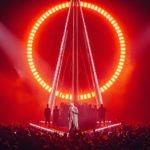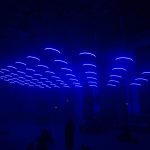I don’t know why you got started designing lights, but for me, it was color. Specifically, how color acts as a direct visual manifestation of my feeling about a piece. I’m sure there are people who get into creative pursuits for other reasons, but for me, I can not imagine doing so without it being driven by a desire to create and participate in a work of performative art. It was music that did it first, followed in short order by dance. And that is how every project begins for me — with some initial creative impulse. Everything else derives from there.
Both Sides of the Brain
It can be difficult coming to terms with the fact that the creative impulse is not enough. It feels so right; how can it be wrong? For one thing, this is design, not fine art. As such, there are the competing needs, visions, and creative impulses of our collaborators. For another thing, there are very precise and rigorous steps we must take in order to achieve specific lighting effects. Even something so basic as a system of three unit dance booms requires rigor and attention to detail in terms of fixture selection, placement relative to masking, focus, shutter cuts, and all manner of technical Left Brain details before we even get to creative Right Brain concerns like color selection and intensity values.
The process of developing a design begins with a creative impulse but quickly shifts to analytical reasoning. What equipment and how large a budget I have determines how that sky drop will be lit over the course of the show. My soul may be filled with grand visions of rich multilayered textures in the sunset, but budgets will only allow for three color tops and a four color groundrow. We must take the creative impulse and guide it carefully through a rigorous analysis of our resources in order to best fulfill the creative needs of the piece. Can I thin out the scroller sidelights to boost the cyc lighting? Will that be more in line with my feelings about the show?
The opposite situation can be just as difficult to navigate. That stark, cold opera which gets presented in a rock venue where you have scores of Vari*Lites, dozens of scrollers, a handful of strobes, audience blinders, and on and on can get lost if you are not careful. The rigor needed to stay on track with the aesthetic of the piece and use the technology to further the creative impulse is equal to or greater than that needed to tease out a little more richness in the light. Remember, the R3202 sidelight was a choice, not a limitation forced upon you.
Our job is a curious one. We page through spreadsheets and databases of odd number/letter combinations with arcane names so that we can speak strings of numbers into a microphone and thereby create fantasy worlds. The soul and the mind, the left and right brain, must work in harmony to build creations of any significance.
Emotional vs. Analytic
Working as a designer for live performance, as opposed to being a studio artist, means there are competing demands to our emotional responses. Many of these are basic storytelling concerns like isolating soloists or a lead character to putting a button on a musical number. Structurally, we encounter demands like translating the lush sunset into a bank of ACLs or figuring out how to maintain the integrity of a sidelight system with that damn scenic wall in the way. In each of these instances, our initial creative impulse is guided and carried along by our analytical thinking.
Because of the technical demands a show places on our artistic impulses, it is easy to miss the tree for the leaves, and the show for the Leko. In my experience, our emotional lives and our intellect operate on different principles. They have different ground rules and standards of judgment, and, when left alone, they often come up with conflicting solutions. While complicated, this is a good thing. This is what makes us dynamic and powerful artistic collaborators. It makes us able to navigate emotional artistic conversations with a choreographer, director or composer and talk in terms of shutter cuts and intensity levels with electricians and programmers.
These two components — the emotional and analytic — are important in different ways. Having an emotional connection to the piece is necessary for creating deep authentic work. Yet it is not sufficient. One cannot feel one’s way through drafting a light plot. We must do beam studies and read equipment cut sheets to know what kind of instruments go where. Yet this, too, is not, by itself, sufficient. Strict analytical thinking (with perhaps the sole exception of a dance rep plot), is not enough either. We must have a feel for the piece in order to know what quality of light, which angles, and what colors are best suited to the show. (And even a dance rep plot demands a feel for the kind of work a company tends towards, when choosing systems and rep colors.)
Although articles and whole books have been written on the benefits of blending heart and mind, that way of thinking might be incomplete. The Corpus Callosum is the part of the human brain that allows for communication between the left and right hemispheres. Rather than acting as a single thing, these two aspects of our consciousness work together, like collaborators on a project, each with differing strengths and weaknesses. Rather than a blend of these two aspects of our creative self, they act as a kind of emulsion.
Creative Emulsion
In cooking, when you combine two soluble items, say, water and salt, you end up with a third item, the blended saltwater. While sharing qualities of the two source ingredients, wetness and saltiness, the result is a different yet still single noted experience, salty water. When you combine oil and vinegar, however, you end up with an emulsion of the two, a vinaigrette which retains the discrete flavors of the oil and vinegar but also creates a third flavor experience above and beyond the two source ingredients. Creating an emulsion of our emotional impulses and our analytical thinking creates work far exceeding the possibilities of either of these ways of thinking on their own.
While the emotional impulse of a given lighting idea is always correct, the precise solution it finds is not always dramatically sufficient for the needs of the show. Perhaps the impulse is to have no cues during a particular song. When watching the stage from the tech table, however, it may quickly look flat and uninteresting. Using the intellect to craft a cueing sequence that appears to the audience as a single cue, yet follows the action and music dramatically, creates a unified look that feels dynamic and engages the audience.
At the beginning of our process, the transition from emotional impulse to analysis is slow. We work in large chunks sketching out visual ideas or fitting a desired equipment list into our budgets. As we approach opening, we switch faster and faster between these two aspects. Calling up channels from the magic sheet requires some rapid-fire exchanges between the right and left brain. When everything works, that switching becomes so fast we stop noticing the different modes of thought and become wholly absorbed in the creative process. I have felt, quite literally, like I was flying during creative and successful tech rehearsals.
The best creative emulsions are equally balanced between emotion and intellect. Many of us do not start off so equally balanced. Some of us are more naturally emotional/intuitive. We must build our rational and analytical rigor to a point where it can balance the emotional drive. Others of us trend towards the intellectual/analytic. We must open up spaces of intuitive creation and emotional expression to balance against analytical modes of thought.
We train ourselves and develop our free creativity as well as our analytical precision so they may collaborate. We study painters of light like Caravaggio or Vermeer or John Alton, just as we study cut sheets from Vari*Lite, Martin and High End Systems. From the former, we explore aesthetic heights to which we might aspire. From the latter, we learn how to make that a practical reality. From both, we learn what is possible. It is only when the two sides of the brain are sufficiently developed that we fly.
Lucas Benjaminh Krech, a lighting designer for opera, dance, theater, installations, and performance, often writes on lighting theory and design.


